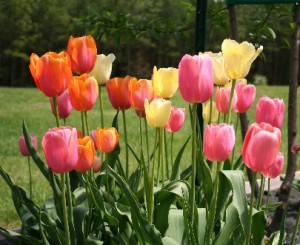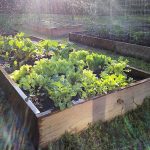If you’re a new gardener, learning how to plant tulip bulbs is fairly easy, and will bring you a lot of satisfaction when your tulips bloom next spring. Tulips are among a group of bulbs called “spring flowering” bulbs. Spring is a term used loosely by the gardening industry; spring means anytime between January and May, depending on where you live.
Please note that this post may contain Amazon affiliate links. Home Garden Joy participates in the Amazon affiliate program and earns a small commission if you purchase products after clicking an affiliate link. This does not affect your price in any way. Thank you for supporting Home Garden Joy.
Directions to Plant Tulips
- Purchase your bulbs.
- Choose a location that gets full sunlight. Full sun means 6 hours or more of direct sunshine every day.
- Look on the back of the package for the planting depth. Typically, this is 6-8 inches.
- Dig a hole about 6 – 8 inches deep and about 3 inches wide.
- Place the bulb “pointy-side up” like a chocolate kiss.
- Fill in the hole with soil.
- Pat the top down with your hand.
Most flowers look best when planted in odd-numbered groups rather than planting them in a straight line, like soldiers. Think about clustering tulips with crocus for several weeks of bloom.
Fertilizer for Tulips
You can add bone meal to the planting hole if you wish to add fertilizer. The ratio is about 1 teaspoon per gallon of soil. I usually just sprinkle some into the hole.
Keeping Pests Away
Mice, voles, and squirrels love to nibble the bulbs. To keep them away, you can use several products that are safe for both people and animals. They leave a bad smell (to the animal – people can’t smell it) or a bad taste.
- Milorganite is an organic fertilizer that smells bad to rodents and deer. Sprinkle it on the soil surface after planting.
- Bonide Repel All is a spray or liquid. Drench the bulbs in it before planting. Always wear gloves when using this product. It can leave a bad taste or smell behind.
When to Plant Tulips
Tulips should be planted in the fall. The correct time to plan them depends on your gardening zone. Usually sometime between the beginning of October and mid November is perfect. The ground is soft enough to dig the required 6 – 8 inches needed for tulips, but the cold weather keeps them dormant.
Why Do Tulips Need Cold Weather to Flower?
Tulips need a period of cool weather to flower. During the cold weather, when temperatures drop below 55 degrees F, the bulbs undergo a chemical process whereby starches and carbohydrates are broken down into glucose. This helps the bulb survive the winter. Changes in light and temperature signal the bulbs to break dormancy. They send up their leaves first, then the flower.
Most Tulips Are Annual Flowers
Tulips should be treated like annuals, which means they bloom for one year, die back and may or may not come back for a second year in a row. While most people do achieve a second blooming year out of beyond, you may see a lot of little bulblets, sort of like cloves of garlic, on the parent bulb. These can be split off and grown into mature tulips but it takes a lot of time. I much prefer going back to the garden center in the fall and buying more!
Types of Tulips
Tulips are grouped into several types. It’s important to know which type you’d like to grow, since not everyone’s idea of a tulip is the same.
- Cottage tulips: Cottage tulips are the traditional, classic late-blooming tulip that most people think of when they hear the word. They have a single, strong stem and a big egg-shaped flower. Most bloom later in the spring, in mid to late May.
- Darwin hybrids: Darwins are among my personal favorites. These are similar to the cottage tulips but may even grow taller and larger. They are also late-blooming flowers. “Pink Impression” is one of the most famous of the Darwin hybrids.
- Parrots: Parrot tulips have fringed, multi-petaled flowers. They are outstanding and showy, but the flower heads can be so heavy they actually pull the entire flower over.
- Rembrandt: The Rembrandt tulips offer striped, splashed flowers. They’re named after the Dutch painter because he included these flowers in many of his paintings. The first Rembrandt tulips occurred when a virus attacked the tulip crop in Holland in the late 17th century. Today, most are hybrids, grown for their flowers (and virus free, thank goodness.)
- Species: Species tulips look more like their wild cousins growing in the hills of Turkey and Asia than others. They have smaller, compact flowers, and bloom in early spring, sometimes as early as March. They are also the best tulips for naturalizing; many will return year after year.
- Lily-flowered: Long, thin petals like a lily.







There is more than I realized to choosing tulips. I’ve had some disappear after a couple of years and I have some that are more fabulous without replanting.
I have new bulbs waiting to go in the ground. Any day now I keep thinking.